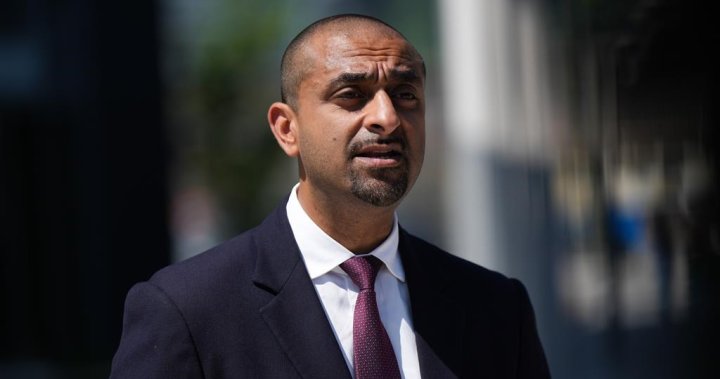As a young man, Julio Punjani hitched his ambitions to a faraway country he knew little about.
Like other Gujarati-speaking Indians, the most important thing he knew about the United States was the opportunities it held.
Forty years later, he’s standing in a crisp black sweater in a gas station he runs just outside Minneapolis. His friend brags that Punjani doesn’t let the frigid cold prevent him from hauling and filling propane tanks himself.
He’s made it in America.
“[My] dream is that in life, you live healthy and happy,” Punjani said, from his gas station in Ham Lake, Minn. “I’m happy health-wise and happy with my life.”
The allure of living in the U.S. still drives Gujarati people, originally from the westernmost state in India. It’s the motivation that tragically led to the loss of the lives of an entire family on Manitoba’s southern border.
Died in search of America
There were 11 undocumented Indian migrants, fluent in Gujarati, who tried to sneak into Minnesota in bitter conditions last month; four of them — a family, with the youngest only three years old — died trying.
The court case against Steve Shand, who was charged with human smuggling in connection with the treacherous trek, will unfold in Minnesota. Court documents say authorities believe he was involved in three additional recent smuggling events.
The seven other migrants who were with the family who died have been released from custody, but will have to report to U.S. Immigration and Customs Enforcement at a later date.
Gujaratis who’ve built a life in Minnesota say they’re shocked by the deaths of the family of four, which exposed the phenomenon of illegal northern border crossings (infrequent compared to crossings at the U.S. border with Mexico).
Many said they’d never heard of Gujaratis trying to sneak into the United States from Canada, especially in wind-whipped whiteout conditions.
“It surprised me. I get so angry about why that thing happened,” Punjani said.
His own American story began in 1982, when he worked as a dishwasher.
Soon, his entrepreneurial tendencies took hold and he was running gift shops in hotels. Then it was gas stations. He was running as many as 18 before he sold most of them. At 61, he wants to start slowing down.
The desire to own a business, he said, is almost embedded in the psyche of Gujaratis of his generation.
Punjani taps his arm to make his point.
“All the Gujarati people have it in their blood — business,” he said.
His friend, Azam Hussain, who is also from India, has long marvelled at the proficiency in business among the Gujaratis he knows.
“People help each other, like three or four people get together and get a business going,” he said. “They put in their efforts and time to make that business successful.”
Many Gujaratis are hard-working people, according to those in Minneapolis and others in the Indian diaspora. Many are university-educated, hold professional jobs and work in IT. The entrepreneurs own gas stations, grocery stores and run hotels and motels.
The India Association of Minnesota estimates around 350 Gujarati families reside in the Twin Cities.
That’s a fraction of the roughly 60,000 Indian-Americans in the state, “but it’s still well-represented,” said president Suyash Jain, who isn’t Gujarati by origin but grew up there.
It hit close to home when he learned the family who died at the border lived in Gujarat, Jain said.
“Most of the people that we know, they all came here either for studies or for skilled labour and they were hired by companies and they got here through proper visas,” Jain said.
“This is something really new and unprecedented for us.”
Jain said America remains a lucrative place, specifically for Indians who want to study.
It’s what brought him to the United States. The same is true with Sreeni Checka, vice-president of the association, but he said those stories are changing. Some Indians don’t remain abroad.
“There’s a constant bidirectional flow of talent and skill now. That is something different from 30 years ago,” Checka said.
The practice of migrating isn’t foreign to Gujaratis.
Sushila Shah grew up in Uganda, but was expelled from the country with many others in 1972 when the country’s president, Idi Amin, ordered the eviction of all Asians.
A wave of Gujaratis settled in the United Kingdom afterwards, including Shah. Her husband’s new accounting job took her to Winnipeg for five years beginning in the late 1970s, until they were persuaded to move to the United States and settled somewhere nearby, Minneapolis.
She and her husband, along with two adult sons, built a comfortable life.
“What more do you want in life?” Shah said.
She said Gujaratis are also motivated to support their children.
“Parents will tie their belly to make sure their children go to school and get a good education.”
She meets numerous Gujaratis now as an interpreter. It ranges from older people who never learned English upon their arrival in the U.S. to newcomers. A few years ago, one person admitted to being smuggled into the country — an admission that floored Shah, she said — but she felt it wasn’t her job to ask questions.
Waiting a decade for a green card
Rishi Oza, an immigration lawyer in Durham, North Carolina, doesn’t condone people who enter the country illegally, but understands some people’s rationale.
Since the United States limits the number of immigrants it accepts from any country, it can present stark differences in green card demand. He said it takes roughly 10 years for someone from India with a master’s degree to be granted admission to the United States, but only a year and a half if that same person is coming from Pakistan, said Oza, who is Gujarati himself.
“What it creates is kind of a perverse incentive,” Oza said. Wannabe Americans know it’ll “take such a long time to come to the United States legally that it pushes people into doing things that might not be the right way of doing it.”

Posters of travel and immigration agents advertising what they describe as easy U.S., U.K. and Canadian visa facilities are pasted throughout the village of Dingucha, where the Patel family that died at the border were from.
Back at one of his Minnesota gas stations, Punjani recognizes the nature of the Gujaratis in America is changing. He said the younger generations don’t hold the same eagerness in running businesses. His own children have no interest in taking over his gas stations.
That’s the way it goes, he said.
“The new generation is different than us.”






More Stories
Canada’s military mission training foreign troops bound for Haiti | Exclusive
Ontario NDP will defy keffiyeh ban if Ford doesn’t step in and end it, says party leader | CBC News
‘Tremendous help’: Hundreds of new shelter spaces coming to Abbotsford – BC | Globalnews.ca